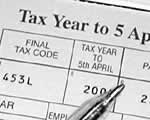


This month we take a closer – although necessarily fairly simplified – look at how an individual’s income tax liability is calculated.
Step 1 – identifying total income
An individual’s total income tax liability for a tax year is calculated on all the various sources of income in that year, so the first step is to identify the taxable amount of income received from each source – such as:
Employment income
The gross earnings will be shown on form P60, but to this must be added the value of any benefits in kind from form P11D. The PAYE deducted is taken into account at Step 4.
Self-employment or partnership income
The amount of taxable income, either from self-employment or from an individual’s share of a partnership’s profits, will, in general, be the amount of net profits (after business expenses and capital allowances) for the accounting period that ended during the tax year in question, although slightly different rules apply in the first and last tax year in which a business is carried on.
Pensions
The state pension is paid gross so the taxable amount is the amount received; other pensions are generally paid after deduction of PAYE, and the taxable figure is the gross amount on form P60 and again any PAYE is taken into account at Step 4.
Interest
Most interest is received net of basic rate tax but the taxable amount is the gross (i.e.: the net interest plus the tax deducted) with the tax already paid deducted at Step 4.
Rental income
The taxable amount is the rent received less expenses relating to the renting of the property. Where there is more than one rental property, income and expenses from each are added together.
Dividends
Dividends are received net of a 10% tax credit – the taxable amount is the net dividend plus the tax credit, with the tax credit taken into account at Step 4.
The sum of all the taxable amounts is the individual’s “total income”.
Step 2 – arriving at taxable income
From the amount above can be deducted various items, the most common being the following:
- Certain allowable losses
- Certain interest payments and pension payments
- Personal allowance – where an individual’s total income exceeds £100,000 the personal allowance is reduced by £1 for every £2 over that threshold until it is completely removed
Step 3 – taxing the income
For 2011/12 the tax rates are as follows:
|
Income |
Tax rate on non-dividend income |
Tax rate on dividend income |
|
1 – 35,000 |
20% |
10% |
|
35,001 – 150,000 |
40% |
32.5% |
|
Over 150,000 |
50% |
42.5% |
It is necessary therefore to determine which income falls into which rate band and to do this, earned income is treated as the first “slice” of income (so that the deductions at Step 2 are deducted first against this type of income), with non-dividend investment income treated as the next slice and dividend income as the top slice.
Where the individual makes charitable donations or pension contributions net of basic rate tax, so that basic-rate tax relief is obtained when the payment is made, the amount of the basic rate band is extended to give higher-rate tax relief for these payments.
To the extent that each slice of income falls into each band, the above tax rates are then applied accordingly and the tax at each rate is calculated.
Step 4 – taking account of tax already paid, tax credits and tax reducers
From the total tax are deducted the following:
- Tax reducers, such as relief under the Enterprise Investment Scheme
- Tax credits on dividends
- PAYE deductions from earnings or pensions
- Tax deducted at source from savings income
The resulting amount is the tax payable for the year; where the PAYE or tax deducted on savings income exceeds the liability, a refund is due; however tax credits on dividends cannot create a repayment.
Step 5 – paying the tax due
Subject to any payments on accounts already made for the year in question the tax liability id due for payment by 31 January following the end of the tax year.
Krystyna Knight, of Silver Levene provided research for this article.
Disclaimer
Umesh Modi BA ACA, is a Chartered Accountant and Tax Advisor, and a partner at Silver Levene (Incorporating Modiplus+). He can be contacted on 020 7383 3200 or umesh.modi@silverlevene.co.uk

